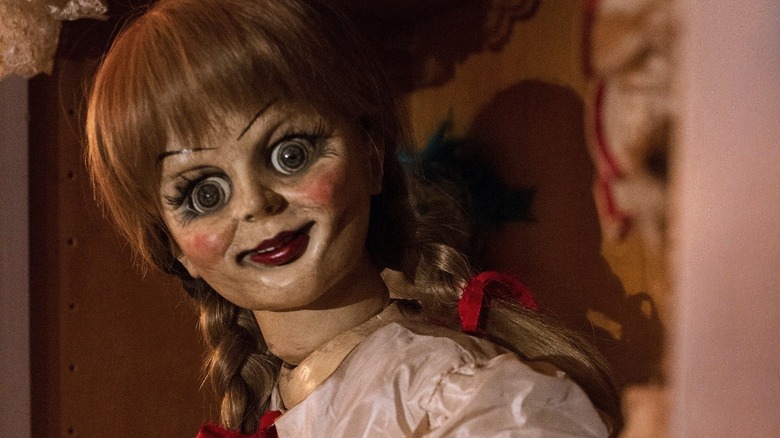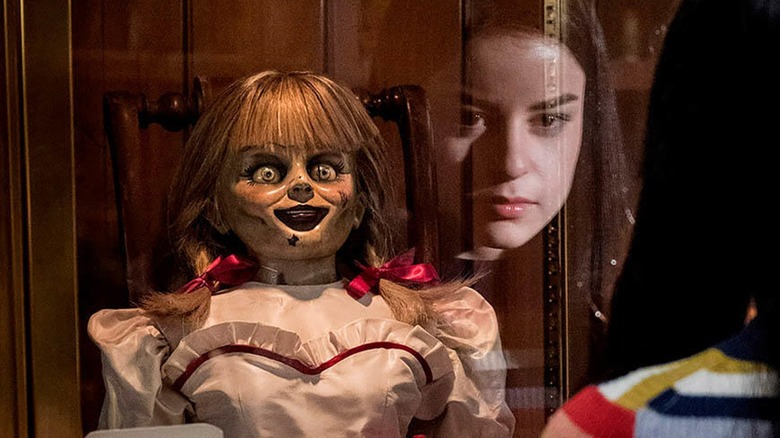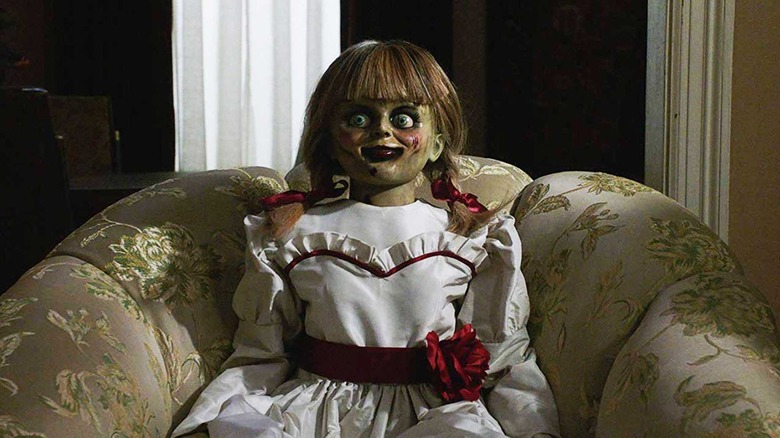Annabelle: The Terrifying True Story That Helped Launch A Horror Franchise
Haunted dolls in horror make for a perfect mix of the occult and the mundane. An everyday object, or toy to be precise, can be responsible for terrors unimaginable once it assumes a life of its own in ways that cannot be explained or articulated. The Conjuring Universe often hinges itself on haunted everyday objects and occurrences, but the Annabelle doll serves as the foundation for a franchise that revolves around the dramatized lives of paranormal researchers Ed and Lorraine Warren. These fictionalized cases, which are allegedly based on actual paranormal activity investigated by the real Warrens, generally deal with evil entities, and Annabelle's introduction to the big screen helped these films gain mainstream attention and balloon into the massive horror franchise we know and love today.
Popular perception of the Warrens, which has almost entirely been shaped by Hollywood portrayal, mars details of actual investigative reports surrounding the cases that the duo handled back in the day. Moreover, dramatized versions of paranormal cases are naturally embellished for narrative reasons, where details are added or altered for shock value and theatrical effect. A lot has been said about the real Annabelle doll and the trail of terror it left behind for those who had the misfortune of owning it — however, it is easy to misconstrue embellishments for fact or take sensationalized paranormal reports at face value. After all, there are marked differences between the garish, terrifying Annabelle of the movies, and the seemingly harmless Raggedy Ann doll steeped in mysterious notoriety.
Here's a look at the long, convoluted history of the Annabelle doll, and the dark, murky legacy it leaves behind for such a popular horror franchise that still endures.
A birthday gift
While it is impossible to deduce exactly what actually happened, several sources point towards the fact that the real Annabelle was a gift given to a student-nurse named Donna on her birthday in 1971. The doll was a hand-me-down from a hobby store, and Donna was initially thrilled to have gotten Annabelle. Soon, Donna and her roommate Angie began to notice strange behavior exhibited by the doll, where micro-movements gradually escalated to more aggressive ones, such as when the doll moved from one room to the next. While this could have been a simple case of shared paranoia, the girls' mutual friend, Lou, believed that the doll was possessed, and soon after, sinister notes were found strewn all across the apartment, including ones that said "Help Lou" or "Help us."
Even after these strange things occurred, Donna and Angie tried to rationalize them to the best of their abilities. However, one day, Donna returned home to find the doll with blood on its hands, which prompted the arrival of a medium. The medium told the girls about the death of a child named Annabelle, whose spirit was allegedly attached to the doll, which led Donna and Angie to try their best to accommodate the seemingly possessed doll. After Lou suffered scratch marks when no one was home, the Warrens came in soon after and deduced that Annabelle's goal was to take possession of Donna's soul.
While there is no way to actually support or debunk these events, it is clear that the involvement of the Warrens led to the doll being kept in the duo's now-closed occult museum, where it still resides. The Warrens took Annabelle with them after declaring that the doll was possessed and allegedly encountered strange phenomena on their way back, including object levitation and vehicular mishap.
The idea of evil
The Annabelle doll depicted in the "Conjuring" films does not resemble the Raggedy Ann doll in any capacity, as it exudes a deliberately menacing aura meant to scare and unsettle. "The Conjuring" director James Wan said that the doll "gave off an inherently creepy vibe" and that he knew that there was something special about it "when people would go out of their way to avoid Annabelle on set" (via USA Today). The reason behind this can be attributed to the power of suggestion, as the fictional doll embodies the real doll's perceived aura of evil, along with the uncomfortable feelings it manages to elicit. Whether the real Annabelle doll is truly haunted or not is immaterial.
Moreover, Tony Spera, the owner of the Warren occult museum and son-in-law of the renowned couple, told The Hollywood Reporter that the doll's mythology was captured pretty well by the films, even though its dramatized origins were far more exaggerated than the one in reality. Spera also added a few embellishments to the Donna and Angie story, claiming that "Annabelle's two flimsy little cloth arms levitated onto the table," although it is unclear whether this actually happened. Apart from this, Spera went into further detail about the emotions evoked by the doll when it was in Donna's apartment, including sudden feelings of terror and nightmares that felt all too real.
Whether the true Annabelle is possessed or not, the idea of the doll is enough to evoke horror and fuel fears tied to a franchise that is still going strong. While the real doll sits inside a glass case, the mythos surrounding Annabelle grows.


